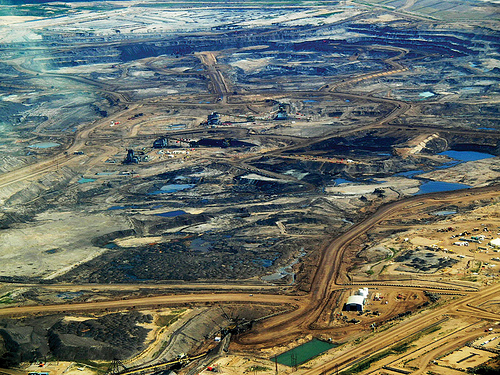
Petroleum extraction from “tar sands” – in Alberta Province, Canada (pictured), or elsewhere – is not “clean energy” production. Photo credit: howlmontreal (via Flickr, Creative Commons license).
In the famous words of many politicians, “elections have consequences.” As U.S. President Barack Obama begins his second term in office, he will have a momentous choice to make on whether the proposed Keystone XL Pipeline – to connect Alberta’s huge tar sands deposits with the Gulf of Mexico – will move forward. And, given the recent indications of Obama’s new Secretary of State, a final decision on the pipeline’s fate is looming. There can be no doubt that a Mitt Romney administration would have quickly approved this massive infrastructure project on national security and economic grounds. Given Obama’s recent signals on climate change, though, approval of the Keystone project is in doubt.
Canada, of course, is lobbying hard for U.S. approval of the new pipeline. If connected with potential markets, the tar sands deposits in Alberta could place Canada on par with Saudi Arabia, in terms of fossil fuel exports. And as the energy geopolitics expert Michael Klare argues, the death of the Keystone XL Pipeline could be the death of the Canadian tar sands industry. That is not a minor diplomatic proposition, even among old allies.
The green coalition opposed to the pipeline is right to raise the long-term, global issues associated with climate change. For so many reasons, mobilizing action on climate change in America has been fraught with difficulties. It has now been over twenty years since the Rio Earth Summit placed a spotlight on the negative impacts of climate change. At some point – and soon – elected officials must show some true courage on these issues. Klare is right to identify the Keystone decision as a defining climate policy choice for Obama’s presidency.
So, here is a short list of other geopolitical relationships that Obama should weigh carefully in his decision:
- Global food security is at stake. Modestly cheaper energy prices won’t matter much if they are overwhelmed by much more expensive food, caused by climate change. Nor should we overlook the destabilizing effects of higher food prices in weak and failed states.
- The geopolitics of climate change is about much more than rising temperatures. One of the central risks of global climate change – already being observed – is restructured precipitation patterns. Though there has been too much hype to date about “water wars,” there are many plausible future scenarios under which states will go to war in a bid for fresh water.
- Climate change – barring a reversal of our present global course – is likely to lead to more civil wars and regional conflicts around the world.
Mr. Obama (and Mr. Kerry), the ball is in your court.